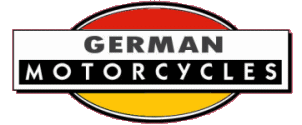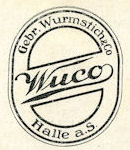

This page lists brands for which we currently have only an historical precis, beginning with the letter "W".
For a more complete listing visit the German Index.
Wackwitz
Paul Wackwitz of Crefeld (now Krefeld, near Dusseldorf) built 106cc four-stroke bicycle attachment engines supplied separately or complete with bicycle frames. His business was established in 1904 or possibly earlier, and was listed at several addresses in Crefeld over the years.
The Wackwitz appeared in local racing results in 1923, and the brand was offered by a nearby dealer in 1924. The company experience financial difficulties in 1925, and little more was heard of it before it was disolved in 1929.
Sources: Tragatsch p294; Motopedia.
Walmet
Manufactured by Waldecker Metallwarenfabrik, Leopold Weste Comp., Bad Wildungen 1924 to 1926
Built motorcycles with their own 246cc two-strokes and also used 346cc Kuhne ohv engines.
Sources: Tragatsch p294; period literature.
Walmobil 1919
Walcher Sidecars 1985~1995
Weber-MAG
1926-27
Leo Weber (Motorradbau, Mannheim) built a range of motorcycle using ioe MAG engines of 346cc, 498cc and 746cc.
Sources: Tragatsch p295
Wecoob
1925-30
Quite a range of machines were constructed using 142cc Rinne two-strokes, 172cc to 347cc Villiers, and 348cc to 997cc JAP engines. Actual production figures were low.
Source: Tragatsch p295
Wegro 1922-1923
Weise
1925-1939, Berlin
Using engines from Rinne and JLO, Weise & Co built commercial three-wheelers (Liefermotorrad). The engines were mounted above the front wheel.
Source: wikipedia.de
Weiss 1925-1928
WEKO
Manufactured by Wemhöner, Hilbert & Co. of Bielefeld, 1924-1926
Weko motorcycles were powered by 250cc engines built in their factory. The firm, which had been long established in the bicycle industry, did quite well in local motorcycle competitions.
Source: GTU Oldtimerservice
Wela
1925-27
Built in Apolda, Thüringen, using ohv 348cc Kuhne engines designed by Gnadig
Source: Tragatsch p295
Wels
Manufactured by Motorfahrzeuge Wels, Bautzen Hussar barracks, Bautzen, 1925-1926
Model WTS 26 was fitted with an ohv 348cc Kühne, and another had a 490cc ohv JAP engines. The frames were similar to those of BMW.
In 1926 a machine was announced powered by a Kurchen engine, and a 1000cc JAP was also on offer. That year, the business closed.
Kurt Schieback's KSB was listed at the same address.
Sources: Tragatsch p295; Motopedia.
Welt-Rad
Manufactured 1901-07
Established bicycle firm in Schönebeck (Elbe) which fitted 3.5hp singles and 6hp v-twin engines of their own construction into robust frames.
Source: Tragatsch p295
Wellerdiek 1927-1970s
Wendax Commercial Three-wheelers, 1932-1951
Werno 1921-1923
Wesnigk 1923-1925
Wiga
1928-1930
Wiga-Werk in Ludwigshafen built well-designed motorcycles using Kuchen and JAP engines of 198, 348cc and 498cc. There may also have been a smaller engine.
Source: Tragatsch p297
Wikro
Manufactured by WG Krauss & Co. of Cologne, 1924-1926
Initially Wikro sold (possibly rebadged) Toreador motorcycles with 346cc Precision engines, and then from 1925 offered machines with 347cc and 497cc Blackburne units.
Sources: GTU Oldtimerservice, Tragatsch.
Wimmer 1928-1938
Windt
In 1954 to 1958 Fritz Windt of Lage, Lippe, built mopeds with Sachs and JLO engines. Models include: W 50 (JLO FP 50) 1954 and W 56 (JLO FP 50) 1954.
Sources: Moped Archive, GTU Oldtimerservice
Wittekind
Manufactured by Wittekind-Fahrradfabrik of Bielefeld from 1952 to 1955
The bicycle factory produced mopeds with engines from Sachs and Zündapp.
Source: GTU Oldtimerservice
N.B. Wittekind Automobile AG of Berlin (1920s) does not appear related.
WK
1920-22
Built in Berlin along the lines of the British Auto-Wheel, this was an engine built into a wheel which could be attached to a bicycle. Believed to have used a 249cc sv Hilfsmotor from WMB.
Source: Tragatsch p298, motor-hist-foto.de.
WMB
1924-26
Built limited numbers of light motorcycles with 1.8 hp sidevalve engines of their own production. Believed to have built a 249cc sv Hilfsmotor supplied to WK.
NB. There is reference to a Hungarian marque of this name in the 1930s built on Csepel Island; the information refers to the Weiss Manfred marque.
Sources: Tragatsch p298, Wikipedia.de
WOAG 1921-1926
Wotan
Manufactured by Wotan-Werk AG, Leipzig, 1923-1925.
Engines were mostly 170cc two-strokes.
The history of the firm stretches back to 1883. It had numerous transformations over the following 100 years becoming a leading manufacturer of machine tools. The Russians took much of the factory tooling after the war, and this was followed by decades under the Soviet thumb. After the wall came down things began to improve, and today, as WEMA, the company thrives.
Sources: motorräder-aus-leipzig.de, et al
WSE
1924-25
Görlitz firm built light motorcycles with their own 249cc sidevalve engines. These engines were sold to other manufacturers.
Source: Tragatsch p298
WSM
1919-23
Based in Sudbauer, Munich, the firm built motorcycles using 493cc sv HO engines and also the Stolle-designed ohv flat twins which they supplied to Victoria before that company bought the WSM factory.
Source: Tragatsch p298
Wuco

Manufactured by Gebr. Wurmstich & Co., Fahrzeugerzeugung, Halle an der Saale in 1925
Built motorcycles using their own 174 cc sv engine and also used JAP 238, 348 and 490cc sidevalve units.
Sources: Tragatsch p299, motor-hist-foto.de.
Wulfhorst c.1987
Wünsche Sidecars
Established in Pirna in 1943, at the end of the 1940s the company became Wünsche & Stäps and began vehicle construction.
Manufacture of sidecars began around 1952, similar in style to those of Stoye. Aluminium bodies appeared for the 1957-58 season, and all models including these were offered for fitment to Jawa, MZ, AWO and Pannonia. Some 100 to 120 sidecars were produced each year up until 1966 when production ceased.
Somewhat later, replicas of the Wünsche sidecars were produced by Waldmann Fahrzeugbau.
Source: Gespann-Lexikon
Würdig 1923-25
Rarer German Marques